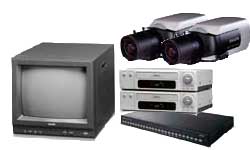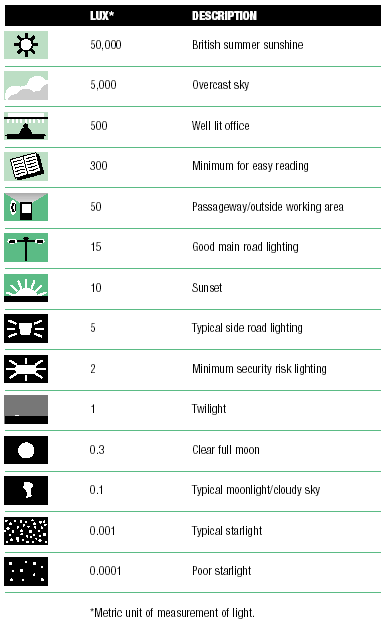|
Capturing Image
Introduction
Specification of the right CCTV camera for a project is
not always the easiest of processes. There are many factors that
have to be taken into account: technical specifications, the
application and its requirements, as well as any physical
constraints the site may impose. With ever increasing product
ranges available in the marketplace, and technology constantly
evolving to optimize performance, reliability and functionality,
it is quite a challenge to make an informed decision to meet the
requirements for the job whilst remaining within projected
budget. Understanding the many variables within CCTV camera
technology today can only be an advantage in helping you make
the right choices. |
 |
From here, the rest of this white paper explains the internal
features of Video Camera and the working principle of Lens.
CCD Camera Sensor
VisionNet Video Camera consist of CCD image sensor as it produces
high quality image, especially in 3D environment.
The CCD is comprised of about 500,000
light sensitive cells called picture elements (pixels) which convert
the light falling onto its surface into an electrical signal. The
performance of the camera affects by 3 factors:
1. Image Sensor
2. Lens
3. Illumination
However, Video Camera Image Quality are more dependent upon the
quality of the CCD than any of the other camera components.
Currently, the popular formats are:
| 1/2"
Half-inch |
High
performance for high sensitivity and low noise |
| 1/3"
Third-inch |
Most
popular and ideal but high cost |
| 1/4"
Quarter-inch |
A recent
development, produce excellent image with low cost |
Benefits of CCD Technology
|
Long Life |
Produced with a design life of up to 10 years |
|
Shock Resistant |
Much more rugged than older tube technology |
|
Size and Weight |
Have enabled the miniaturization of cameras |
|
Spectral Response |
Responsive in the near infra red area |
B/W and Color Camera
Basically, Video Camera divides into two main categories:
B/W and Color Camera.
Broadly speaking, all video camera sensors are B/W, color is
obtained by inserting red, green and blue filters in front. As in
reality, those color filters differ some part of incoming light that
results less light going to the image sensor successfully. This is
why color cameras have less resolution than B/W cameras. Also due to
the filters, color cameras are not sensitive to infrared light.
Therefore all the discussion on camera sensitivity and suitability
for infrared illumination is confined to B/W cameras. This is except
for the Dual Mode cameras now becoming available which potentially
offer the best of both worlds - VPC-400N.
B/W cameras can offer Infra Red (IR) sensitivity
allowing their use with covert IR illumination possible. This can be
particularly useful where planning permission makes extra lighting
impractical or the security requirement is such that intruders
should not be alerted to the existence of CCTV surveillance.
However, in most cases, color cameras are still the
best choice as it produces crystal and clear image for what is
happening or what exactly is moving in the targeted site. In the
incident of crime, color camera can distinguish whether the suspect
person is wearing blue jacket or grey jacket, while B/W camera
produce the same color whatsoever.
Light and Illumination
In the world of Video Camera, light is vital to produce any image. The type of lighting
used, and the correct positioning, are vital to maximum security. Everyday
White or Daily light is actually a mixture of colors of different frequencies.
Video Camera is more receptive to certain color
combinations than others. The best results are usually obtained by matching the spectral
response of the camera to the light illuminating the scene. The amount of light reflected from an object
determines how ‘bright’ it appears.
During the designation of a
security deployment, lighting takes the first account of choosing
the right camera. Amount of Light is measured by Lux. One unit of
Lux can be represented by the amount of light generated from a
burning candle.
Only natural light provides absolutely even
illumination, although it is of course affected by clouds and
shadows. All forms of artificial light suffer from the fact that as
the distance increases from the light source so the illuminance
reduces. This is due to the inverse square law of illumination where
the illuminance falls to a quarter of its value if the distance is
doubled..
Inverse Square Law Of Illumination
As the luminous flux travels away from the light source the area
over which it spreads increases, therefore the illuminance (lux)
must decrease. The relationship is expressed by the inverse square
law and illustrated below:

Inverse Square Law Of Illumination
The relationship between illuminance and it's
effect at a distance is given by:

This factor is particularly important in
considering the light available for a camera. For instance a light
source providing a level of 30 lux at 20 Metres will provide 7.5 lux
at 40 Metres and only 3.3 lux at 60 Metres. The other effect of this
is that the wide range of light levels can cause problems with
automatic iris lenses. Unless set up correctly, the foreground light
will cause the iris to close and lose definition in the distance.
The reverse is if the iris is set to the distant light level in
which case there will be a lot of flare in the foreground.
Sensitivity
Color cameras generally
perform less well in low light than B/W cameras, all other things
being equal. Sensitivity is usually measured by reference to minimum
illumination lux level at which a camera can produce an image. The
lux valuation, although usually referred to as a metric unit of
measurement of light, is very often applied subjectively to the
ability of a camera to produce images.
For instance: VPC-400N Video
Camera produce image with minimum illumination of 0.03 at F1.2 Lux.
*Actual amount of Lux falls into the image sensor differs
considerably from the factors of Lens and Illumination.
F-Number
The f-number of a lens is the ratio of the focal length to the
effective object lens diameter. It is a mechanical ratio and does
not infer the efficiency of a lens. It does affect the amount of
light energy passed to the sensor and will play a significant part
in the resulting picture. In simple terms the smaller the f-number
the more light is passed to the sensor, therefore f1.2 is better
than f1.8. The percentage of light passed by different apertures is
listed below. This shows the percentage of light falling on the lens
that is passed to the sensor.
|
F number |
f1.0 |
f1.2 |
f1.4 |
f1.7 |
f2.0 |
f2.8 |
f4.0 |
f5.6 |
|
% passed |
20% |
14.14% |
10% |
7.07% |
5% |
2.5% |
1.25% |
0.625% |
Here is a simple illustration of how much Lux in
different environment

For more
information:
Video Camera Selection Guide - White Paper | 
